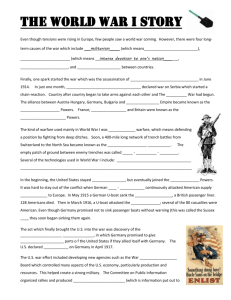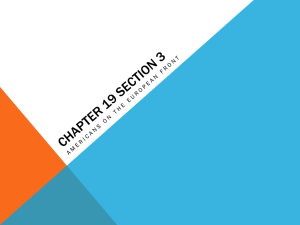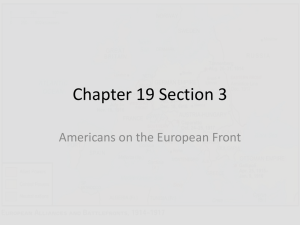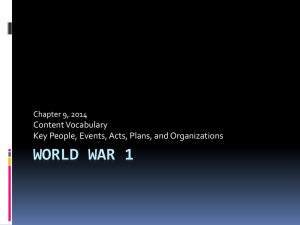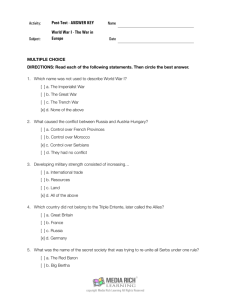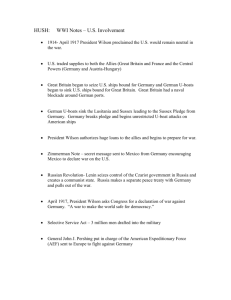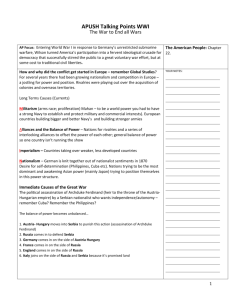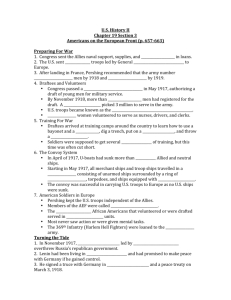World War I - Cathedral High School
advertisement
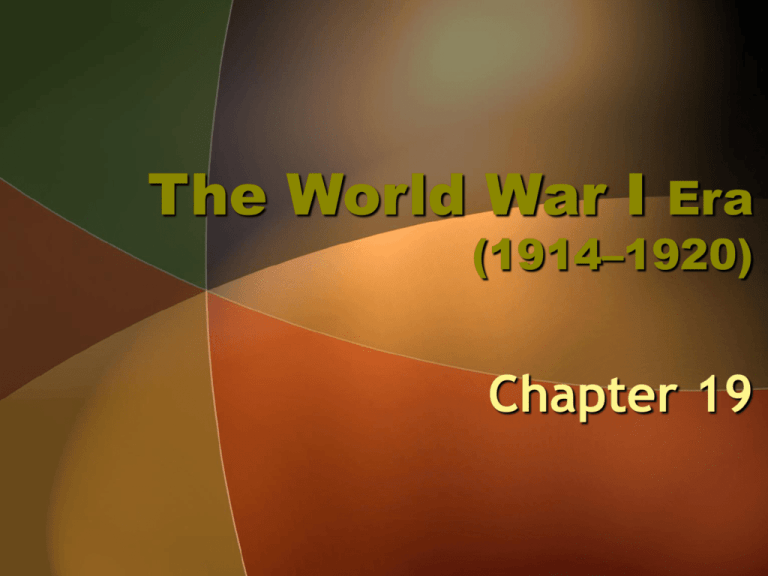
The World War I Era (1914–1920) Chapter 19 Section 1: The Road to War A. Causes of World War I Chapter 19, Section 1 Main Causes of World War I 1 .Imperialism Competition for colonial lands in Africa and elsewhere led to conflict among the major European powers. 2 .Militarism By the early 1900s, powerful nations in Europe had adopted policies of militarism, or aggressively building up armed forces and giving the military more authority over government and foreign policy. 3.Nationalism One type of nationalism inspired the great powers of Europe to act in their own interests. Another emerged as ethnic minorities within larger nations sought self-government. 4. Alliances In a complicated system of alliances, different groups of European nations had pledged to come to one another’s aid in the event of attack. 1. Imperialism --Economic & Imperial Rivalries 2. Militarism (& Arms Race) Total Defense Expenditures for the Great Powers [Ger., A-H, It., Fr., Br., Rus.] in millions of £s. 1870 1880 1890 1900 1910 1914 94 130 154 268 289 398 1910-1914 Increase in Defense Expenditures France 10% Britain 13% Russia 39% Germany 73% Militarism cont. • Germany was competing with the UK to build battleships. • The British feared an attack on their Empire Militarism cont. • Germany was competing with Russia and France to expand their armies 1880 1914 • Germany 1.3m 5.0m • France 0.73m 4.0m • Russia 0.40m 1.2m 3. Nationalism 4. The Alliance System Allied Powers: Central Powers: The Major Players: 1914-17 Allied Powers: Central Powers: Nicholas II [Rus] Wilhelm II [Ger] George V [Br] Victor Emmanuel II [It] Enver Pasha [Turkey] Pres. Poincare [Fr] Franz Josef [A-H] B. How the War began-the spark The Assassination of Archduke Franz Ferdinand of Austria-Hungary The spark that ignited the power keg and started World War I: Who’s To Blame? Seal of the Black Hand group • Convinced that Serbia was behind the Archduke’s assassination, Austria-Hungary declared war on Serbia on July 28, 1914. • Russia, as Serbia’s protector, began mobilization, or the readying of troops for war. • France, Russia’s ally, and Germany, Austria-Hungary’s ally, also began mobilization. • Germany, located between France and Russia, wanted to conquer France quickly to avoid the need to fight on two fronts. To get to France, German forces had to pass through neutral Belgium; the invasion of Belgium brought Britain into the conflict as well. • One week after the war started, all the great powers of Europe had been drawn into it. Germany and AustriaHungary formed the Central Powers, while Russia, France, Serbia, and Great Britain were called the Allies. The Crisis cont. • “Black Hand” terrorists attack the Arch Duke • Bomb attempt fails in morning • Gavrilo Princip shoots Archduke and wife in the afternoon. • Austrians blame Serbia for supporting terrorists. C. The Schlieffen Plan • Germany’s military plan to defeat France and Russia. • Germany could not win a two front war. They must deliver a “Knock out blow” aimed at France first. • Avoid French defences by invasion of Belgium. Britain’s Reaction to invasion of neutral Belgium • 1838- UK had signed a Treaty to protect Belgium. • Britain also scared of Germany controlling Channel ports. • Did not want Germany to defeat France and dominate Europe. Britain next? • UK issued ultimatum to Germany to withdraw troops from Belgium. War declared August 4 1914 German Atrocities in Belgium D. Stalemate and Modern Warfare Stalemate on the Western Front • By September 1914 the German advance on Paris had been stopped. The war had reached a stalemate, a situation in which neither side is able to gain an advantage. • Both sides holed up in trenches separated by an empty “no man’s land.” Small gains in land resulted in huge numbers of human casualties. • Both sides continued to add new allies, hoping to Central Powers gain an advantage. Allied Powers Trench Warfare The soldiers had very little decent food, and what food they had was often attacked by rats. These rats were the size of small rabbits and badgers because they had fed on the decomposing bodies of dead soldiers. Many men killed in the trenches were buried almost where they fell. If a trench subsided, or new trenches or dugouts were needed, large numbers of decomposing bodies would be found just below the surface. These corpses, as well as the food scraps that littered the trenches, attracted rats. One pair of rats can produce 880 offspring in a year and so the trenches were soon swarming with them. • Some of these rats grew extremely large. One soldier wrote: "The rats were huge. They were so big they would eat a wounded man if he couldn't defend himself." These rats became very bold and would attempt to take food from the pockets of sleeping men. Two or three rats would always be found on a dead body. They usually went for the eyes first and then they burrowed their way right into the corpse. • One soldier described finding a group of dead bodies while on patrol: "I saw some rats running from under the dead men's greatcoats, enormous rats, fat with human flesh. My heart pounded as we edged towards one of the bodies. His helmet had rolled off. The man displayed a grimacing face, stripped of flesh; the skull bare, the eyes devoured and from the yawning mouth leapt a rat." Rats killed in one trench The British government wanted to encourage men to enlist for war. They said the war would be safe, hardly any fighting, a good lark and over by Christmas. A picture of soldiers going ‘Over the Top’ They used advertising posters to encourage this idea! Modern Warfare • Neither soldiers nor officers were prepared for the new, highly efficient killing machines used in World War I. • New weapons killed thousands of soldiers who left their trenches to attack the enemy. • The machine gun / hand grenade / artillery / bayonet / poison gas / flame thrower / submarine / airplane /barbed wire / Weapons of WWI New Technology + old tactics = horrible losses Trench knife Trench Shovel-Germans Gas Masks German stick grenade WWII grenade At times electrified cable ran thru the mass of barbed wire-had to be cut first! Barbed wire strung out over No Man’s Land slowed speed of the advance of the attacking troops The Machine Gun Germans first to mass produce it– the British thought it was not “sporting” Poison Gas Chlorine Gas – 1915 Germans first used it rags soaked in water or urine Gas Mask Mustard Gas-sulfuric acid gas - yellow Mustard Gas The most lethal of all the poisonous chemicals used during the war, it was almost odorless and took twelve hours to take effect. Yperite was so powerful that only small amounts had to be added to high explosive shells to be effective. Once in the soil, mustard gas remained active for several weeks. The skin of victims of mustard gas blistered, the eyes became very sore and they began to vomit. Mustard gas caused internal and external bleeding and attacked the bronchial tubes, stripping off the mucous membrane. This was extremely painful and most soldiers had to be strapped to their beds. It usually took a person four or five weeks to die of mustard gas poisoning. One nurse, Vera Brittain, wrote: "I wish those people who talk about going on with this war whatever it costs could see the soldiers suffering from mustard gas poisoning. Great mustard-coloured blisters, blind eyes, all sticky and stuck together, always fighting for breath, with voices a mere whisper, saying that their throats are closing and they know they will choke." British-first tanks Tanks Early tank-Little Willie 1915 French Tank German Tank – lagged behind Allies in tank development Both sides used bolt action rifles for the infantry U-boats Submarines U-Boats In the beginning they surfaced to warn the other ship 1918 depth charges improved 1917 Convoy system used by British + French to get US weapons to Europe Fokker Dog Fight Airplanes The Flying Aces of World War I Eddie Rickenbacher, US Francesco Barraco, It. Eddie “Mick” Mannoch, Br. Willy Coppens de Holthust, Belg. Rene Pauk Fonck, Fr. Manfred von Richtoffen, Ger. [The “Red Baron”] Zeppelins Flamethrowers • By 1912 Krupp had produced a 420mm weapon that fired a 2,100 lb shell over 16,000 yards. As it weighed 175 tons, it was designed to be transported in five sections by rail and assembled at the firing site. This concerned the German Army and they asked for it to be adapted to be moved by road. By 1914 company had produced a mobile howitzer called Big Bertha (named after Gustav Krupp's wife). This 43 ton howitzer could fire a 2,200 lb shell over 9 miles. Transported by DaimlerBenz tractors, it took its 200-man crew, over six hours to re-assemble it on the site. E. The American Response 1914 -1916 Chapter 19, Section 1 • Because many Americans were European immigrants or the children of European immigrants, many felt personally involved in the escalating war. Although some had sympathies for the Central Powers, most Americans supported the Allies. • Support for the Allies was partially caused by Germany’s rule by an autocrat, a ruler with unlimited power. In addition, anti-German propaganda, or information intended to sway public opinion, turned many Americans against the Central Powers. • To protect American investments overseas , President Wilson officially proclaimed the United States a neutral country on August 4, 1914. F. The Preparedness and Peace Movements Chapter 19, Section 1 The Preparedness Movement • Americans with business ties to Great Britain wanted their country to be prepared to come to Britain’s aid if necessary. • In an effort to promote “preparedness,” the movement’s leaders persuaded the government to set up military training camps and increase funding for the armed forces. The Peace Movement • Other Americans, including women, former Populists, Midwest progressives, and social reformers, advocated peace. • Peace activists in Congress insisted on paying for preparedness by increasing taxes. Although they had hoped that a tax increase would decrease support for preparedness, the movement remained strong. Section 2: The United States Declares War A. The course of the war 1914-1916 Both sides use a naval blockade to stop supplies-British surface ships Germans -- submarines 1914-1915 Germans stopped in the West—1915-1916 trench warfare brings stalemate in the West. Russians retreat in the East B.The Germans lost the propaganda war to win the U.S. over to its’ side. • When the British cut the transatlantic cable, which connected Germany and the United States, only news with a pro-Allied bias was able to reach America. American public opinion was therefore swayed against Germany’s U-boat tactics. • Sinking of passenger ships and a proposed deal with Mexico also hurt German popularity. 1. The Sinking of the Lusitania • On May 7,1915, a German U-boat sank the British passenger liner Lusitania, which had been carrying both passengers and weapons for the Allies. • Since 128 American passengers had been on board, the sinking of the Lusitania brought the United States closer to involvement in the war. 2. The Sussex Pledge • More Americans were killed when Germany sank the Sussex, a French passenger steamship, on March 24,1916. • In what came to be known as the Sussex pledge, the German government promised that U-boats would warn ships before attacking, a promise it had made and broken before. The Sinking of the Lusitania 3. The Zimmerman Note • During this time, Britain revealed an intercepted telegram to the government of Mexico from Germany’s foreign minister, Arthur Zimmermann. • In this telegram, known as the Zimmermann note, Germany offered to return American lands to Mexico if Mexico declared war on the United States. • Neither Mexico nor President Wilson took the Zimmermann note seriously, but it brought America closer to entering the war. C. Early 1917 –The pivotal time. • Germans gamble on (Feb. 1917) unrestricted submarine blockade of England and France. (They know that the U.S. may enter the war against them but they believe that the U.S. can not help enough in time.) • The all out sub blockade works!! The Allies are in danger of loosing the war!!! • April 1917— Wilson asks for and Congress issues a declaration of war against Germany ETC. • The U.S. does make a difference—Convoy System of escorting merchant ships across the Atlantic brings supplies to Br. and Fr. Allied Ships Sunk by U-Boats Sept. 1916-April 1917 May 1917-Jan 1918 In the final analysis, why did the U.S. go to war vs Germany? • Sub blockade by Germans—we violated the German zone (subs had to sink) and not the Br. zone (surface ships could just stop). • Anti German propaganda—only one source of news—sent by the British. • U.S. sales and loans to Allies –$$$ Billionswe enter the war at Allies darkest hour to save our investment. • Wilson favored and admired the British. Americans on the European Front Section 3 A. Us had to build an army from nothing Building an Army Training for War • The United States lacked a • New recruits were trained large and available military in the weapons and tactics force. Congress therefore of the war by American passed a Selective Service and British lecturers at Act in May 1917, drafting new and expanded training many young men into the camps around the country. military. • Ideally, the military • Draftees, volunteers, and planned to give new National Guardsmen made up soldiers several months of what was called the training. However, the American Expeditionary need to send forces to Force (AEF), led by General Europe quickly sometimes John J. Pershing. cut training time short. Chapter 19, Section 3 B. April 1917--Nov. 1917: With U.S. supplies the Fr. and Br. make gains •Convoy system allows supplies to get to Br. and Fr.thru German sub blockade—Germans get no supplies thru Br. Blockade. •US troops not yet in Europe but the allies push back Germans in mid to late 1917. •In the spring of 1917, Germany provided safe passage for Vladimir Lenin, leader of the Russian Bolsheviks, from Switzerland to Russia. •November 1917 Communist Revolution in Russia overthrows govt and made peace with Germany. C. Spring 1918--Germans make one last all out attack •Without Russia in the war it meant that the German military could concentrate exclusively on the Western front. •( March – June 1918) Before the arrival of American troops, Germany launched a furious attack that was able to gain ground in France, coming within 50 miles of Paris. •AEF begins to arrive in large numbers. •General Pershing’s troops (AEF) pushed back the Germans in a series of attacks. •Finally, the German army was driven to full retreat in the Meuse-Argonne Offensive begun on September 26, 1918. D. American Soldiers in Europe • By 1918, European nations had begun to run out of men to recruit. Energetic American soldiers, nicknamed doughboys, helped replace the tired fighters of Europe. • Amer. soldiers were plugged into the front lines where need -most often as part of Br. or Fr. units. Pershing and his AEF were finally given a section of the front to control at St. Mihiel. • Many African Americans volunteered or were drafted for service. However, these men served in segregated units and were often relegated to noncombat roles. E. Ending the War- late 1918 Chapter 19, Section 3 • In the face of Allied attacks and domestic revolutions, the Central Powers collapsed one by one. Austria-Hungary splintered into smaller nations of ethnic groups, and German soldiers mutinied, feeling that defeat was inevitable. • When the Kaiser of Germany fled to Holland, a civilian representative of the new German republic signed an armistice, or cease-fire, in a French railroad car at 5am on November 11, 1918. • Although guns fell silent six hours later, many more deaths were to follow. The influenza epidemic of 1918 killed more people, both in the United States and Europe, than all of the wartime battles. 1918 Flu Pandemic: Depletes All Armies Some estimates place the dead at 20-40 million 50,000,000 – 100,000,000 died By the fall of 1918 a strain of influenza seemingly no different from that of previous years suddenly turned so deadly, and engendered such a state of panic and chaos in communities across the globe, that many people believed the world was coming to an end. It struck with amazing speed, often killing its victims within just hours of the first signs of infection. So fast did the 1918 strain overwhelm the body's natural defenses, that the usual cause of death in influenza patients---a secondary infection of lethal pneumonia---oftentimes never had a chance to establish itself. Instead, the virus caused an uncontrollable hemorrhaging that filled the lungs, and patients would drown in their own body fluids. As their lungs filled … the patients became short of breath and increasingly cyanotic. After gasping for several hours they became delirious and incontinent, and many died struggling to clear their airways of a bloodtinged froth that sometimes gushed from their nose and mouth. It was a dreadful business. Not only was the Spanish Flu strikingly virulent, but it displayed an unusual preference in its choice of victims---tending to select young healthy adults over those with weakened immune systems, as in the very young, the very old, and the infirm. The normal age distribution for flu mortality was completely reversed, and had the effect of gouging from society's infrastructure the bulk of those responsible for its day to day maintenance. No wonder people thought the social order was breaking down. It very nearly did. Americans on the Home Front Section 4 A. Financing the War--how we paid for it • The government raised money for the war in part by selling Liberty Bonds, special war bonds to support the Allied cause. • Like all bonds, these could be redeemed later for their original value plus interest. • Many patriotic Americans bought liberty bonds, raising more than $20 billion for the war effort. Chapter 19, Section 4 B. Managing the Economy Chapter 19, Section 4 •United States entry into the war caused many industries to switch from commercial to military production. Industry was forced to produce war materials and workers could not strike. •Using the slogan, “Food will win the war,” Herbert Hoover, head of the Food Administration. Voluntary meatless-wheatless-heatless days of the week. “Victory gardens” planted. Save Grain-WWI added strength to the prohibition movement --18th Amendment. •Although he had the power to impose price controls, a system of pricing determined by the government, and rationing, or distributing goods to customers in a fixed amount, Hoover preferred to rely on voluntary restraint and increased efficiency. •Daylight savings time was created to save on fuel use and increase the number of daylight hours available for work. This involved turning clocks back one hour for the summer, creating one more hour of daylight. •Women filled “men’s jobs” – earned them the right to vote 19th C. Enforcing Loyalty Chapter 19, Section 4 Enforcing American Loyalty During World War I Fear of Foreigners Fear of espionage, or spying, was widespread; restrictions on immigration were called for and achieved. “Hate the Hun” The war spurred a general hostility toward Germans, often referred to as Huns in reference to European invaders of the fourth and fifth centuries. German music, literature, language, and cuisine became banned or unpopular. Repression of Civil Liberties Despite Wilson’s claim that the United States fought for liberty and democracy, freedom of speech was reduced during the war. Sedition, or any speech or action that encourages rebellion, became a crime. Political Radicals Socialists, who argued that workers had no stake in the war, won popular support in some states. The radical labor organization Industrial Workers of the World (IWW) tried to interfere with war production; vigilantes took the law into their own hands. D. Changing People’s Lives Chapter 19, Section 4 New Roles for Women African Americans and Other Minorities • With much of the work force in the military, factory owners and managers who had once discriminated against minorities began actively recruiting them. • The flood of African Americans leaving the South to work in northern factories became known as the Great Migration. • The diminished male work force also created new opportunities for women. • Many women joined the work force for the first time during the war. Some found work on farms with the Woman’s Land Army; others took jobs traditionally reserved for men. Posters: Wartime Propaganda Global Peacemaker Section 5 A. President Wilson’s Proposals Chapter 19, Section 5 • As the war neared an end, President Wilson developed a program for peace around the world known as the Fourteen Points, named for the number of provisions it contained. • One of Wilson’s Fourteen Points called for an end to entangling alliances; another involved a reduction of military forces. Another dealt with the right of Austria-Hungary’s ethnic groups to selfdetermination, or the power to make decisions about their own future. • Although both Wilson and the German government assumed that the Fourteen Points would form the basis of peace negotiations, the Allies disagreed. During peace negotiations, Wilson’s Fourteen Points were discarded one by one. B. The Paris Peace Conference Chapter 19, Section 5 Wilson Forced to Compromise • Although Wilson claimed that he was not interested in the spoils, or rewards, of war, his Allied colleagues were interested in making the Central Powers pay for war damages. • Wilson was forced to compromise on his views, especially concerning self-determination for former German colonies. The League of Nations • One of Wilson’s ideas, the formation of a League of Nations, was agreed upon at the Paris Peace Conference. The League of Nations was designed to bring the nations of the world together to ensure peace and security. • Republicans in Congress, however, were concerned about Article 10 of the League’s charter, which contained a provision that they claimed might draw the United States into unpopular foreign wars. Chapter 19, Section 5 C. The Peace Treaty • The treaty which was negotiated at the Paris Peace Conference redrew the map of Europe to the Allies’ advantage. • Nine new nations were created from territory taken from Austria-Hungary, Russia, and Germany. Although most borders were drawn with the division of ethnic minorities in mind, the redivisions created new ethnic minorities in several countries. • France insisted that Germany be humiliated and financially crippled. The peace treaty required Germany to pay billions of dollars in reparations, or payment for economic injury suffered during the war. Wilson, however, opposed this plan, claiming that these demands would lead to future wars. • On June 28, 1919, the peace treaty, which came to be known as the Versailles Treaty, was signed at Versailles, outside of Paris. D. Reactions at Home Congress and the Treaty of Versailles • Despite Wilson’s intensive campaign (suffered stroke) in favor of the Versailles Treaty, Congress voted against ratifying it in November 1919. • The United States declared the war officially over on May 20, 1920. It ratified separate peace treaties with Germany, Austria, and Hungary. However, the United States did not join the newly formed League of Nations. Chapter 19, Section 5 Difficult Postwar Adjustments • The war had given a large boost to the American economy, making the United States the world’s largest creditor nation. • Soldiers returned home to a hero’s welcome but found that jobs were scarce. • African American soldiers, despite their service to their country, returned to find continued discrimination. Republicans angry they were not invited The Somme American Cemetery, France 116,516 Americans Died World War I Casualties 10,000,000 9,000,000 8,000,000 7,000,000 6,000,000 5,000,000 4,000,000 3,000,000 2,000,000 1,000,000 0 Russia Germany Austria-Hungary France Great Britain Italy Turkey US
